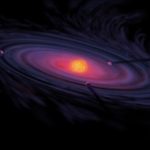Key Takeaways:
- The image showcases 25,000 active supermassive black holes, not stars or galaxies.
- Astronomers used a massive Europe-sized radio telescope to compile the detailed map.
- Black holes emit detectable radiation when actively accreting material, aiding their identification.
- The image covers ultra-low radio wavelengths captured by the LOFAR network in Europe.
- Correcting for ionospheric interference provides a clear view of the ultra-low-frequency sky.
In a seemingly ordinary image of the night sky, something extraordinary is revealed. Each white dot represents an active supermassive black hole, a stark departure from the typical array of stars. These black holes are voraciously consuming matter at the core of galaxies millions of light-years away, making them identifiable. This groundbreaking map, comprising 25,000 such dots, was painstakingly crafted by astronomers using a colossal radio telescope network, spanning an expanse equivalent to Europe’s size.

Astronomer Francesco de Gasperin of the University of Hamburg in Germany emphasized the years of tireless effort required to convert complex radio signals into this captivating celestial portrait. Black holes remain elusive when in a dormant state, emitting no discernible radiation. However, when actively drawing in matter, the intense forces generate detectable radiation across various wavelengths.
What sets this image apart is its coverage of ultra-low radio frequencies, captured by Europe’s LOw Frequency ARray (LOFAR). This intricate network comprises approximately 20,000 radio antennas scattered across 52 locations. LOFAR stands as the sole radio telescope network currently capable of achieving deep, high-resolution imaging at frequencies below 100 megahertz, offering an unparalleled perspective of the cosmos.
Despite its prowess, LOFAR encounters a terrestrial challenge absent in space-based telescopes: the ionosphere. This layer of Earth’s atmosphere poses a particular obstacle for ultra-low-frequency radio waves, which can be reflected back into space. Frequencies below 5 megahertz face opacity due to the ionosphere.
To surmount this hurdle, the team leveraged supercomputers running algorithms to rectify ionospheric interference every four seconds. Over the 256-hour observation period, this necessitated a substantial number of corrections. This meticulous process bestowed us with an exceptionally lucid view of the ultra-low-frequency sky.
Furthermore, this correction process brings an added benefit. It empowers astronomers to scrutinize the ionosphere itself, offering insights into its traveling waves, scintillations, and interaction with solar cycles. This promises a deeper understanding of ionospheric models. The LOFAR LBA Sky Survey (LoLSS) not only offers a wealth of data on known astronomical entities but also holds the potential to unveil previously undiscovered or unexplored objects below 50 megahertz.
The researchers foresee the final release of the survey catalyzing progress across diverse astronomical research domains. More than one million low-frequency radio spectra will be at scientists’ disposal, providing unique perspectives on galaxies, active nuclei, galaxy clusters, and other realms of inquiry. This endeavor represents an unparalleled endeavor to delve into the ultra-low-frequency sky with remarkable angular resolution and depth. The results have been published in Astronomy & Astrophysics.


